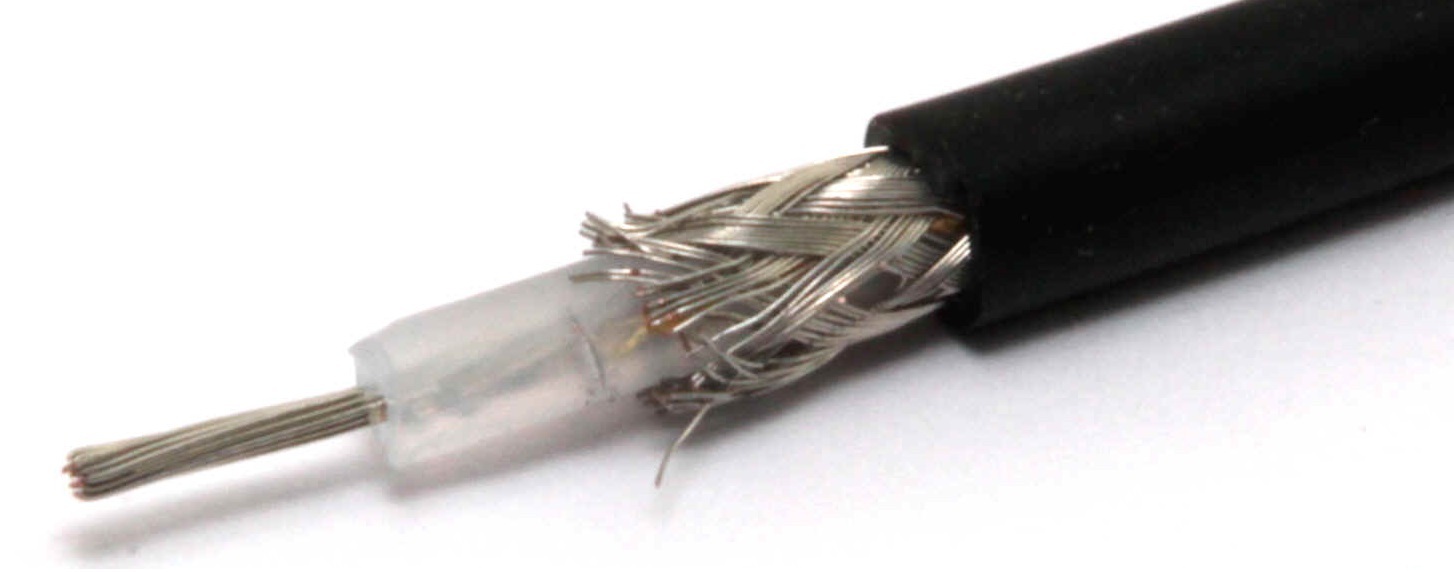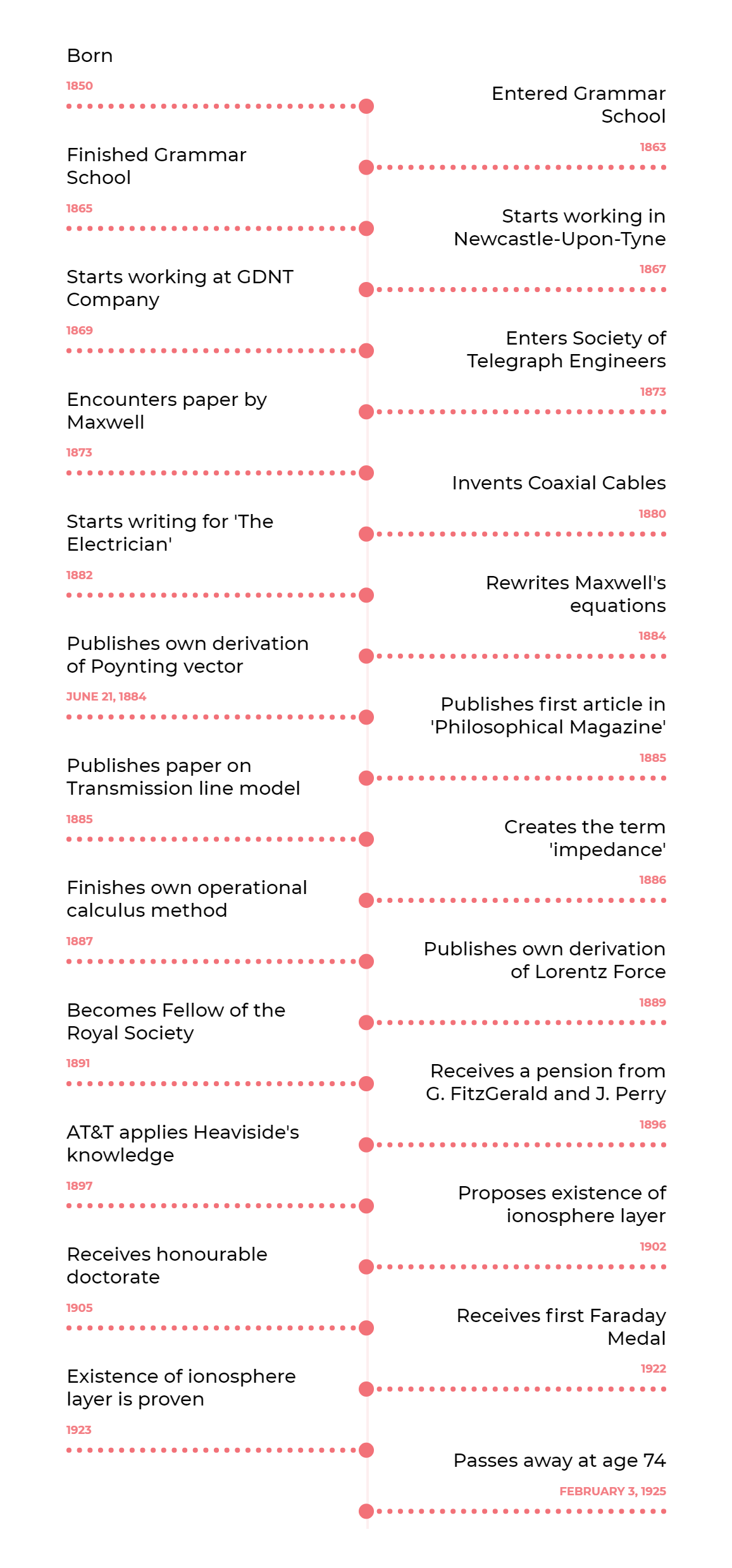Icons of EE: Oliver Heaviside
In the last edition of ‘Icons of Electrical Engineering’ we met Richard Feynman (See Vonk 37-3). Among other things, he is famous for the creation of ‘The Feynman Lectures on Physics’ which are commonly used to lecture students on a wide variety of physics subjects including electrodynamics. As you all (will/should become to) know, electrodynamics can be described by the four Maxwell equations. However, James Clerk Maxwell derived a total of 20 equations with 20 unknowns to describe this part of physics. That is why we have to go further back than the year of 1918 when mister Feynman was born.
It may come as a surprise, but it was not Maxwell who derived the final 4 equations we now use to describe electrodynamics. This can be instead be credited to the man who goes by the name Oliver Heaviside (Footnote: That’s right from the step-function! If you want to know, the inventor himself preferred the notation 1[1]) This is why our story starts halfway through the 19th century in the year 1863 in London. Heaviside enters school at the age of 13 but seeing that he grew up in a rather poor family, his academic career unfortunately ends at age 16. Within this short time Heaviside had managed to end up among the top 5 students of his school. Despite his school career ending short handed, he continued studying on his own.
Short-lived working life
A bit of good fortune came his way as one his aunts married Charles Wheatstone (Get ready we will encounter more familiar names along the way!). This man, known best for his invention of the Wheatstone bridge, was also one of the co-inventors of the first commercially successful telegraph. Seeing that his invention was commercially successful meant that Wheatstone could offer jobs to both Oliver and his brother Arthur Heaviside at his telegraphing company in Newcastle-upon-Tyne. During this period Heaviside studied languages such as German and Danish, but also topics such as electricity and morse code. Which made him more so eligible for a job as a telegraph operator at the Danish Great Northern Telegraph Company in Denmark. After gaining experience for 3 years he moved back to Newcastle-upon-Tyne to handle overseas communication for the Danish Great Northern Telegraph Company. Like his school-career, his professional work-life was also rather short. Again, Heaviside did not waste his time and as he quit his job as a telegrapher, he went on to study and research from the safety of his parental home. During this time he made another useful invention, particularly for telegraphic purposes, namely the Coaxial cable, or as the original patent describes it: “two insulated conductors […] one of them inside the other”[2]. At the time, coaxial cables would mostly be applied to eliminate crosstalk between parallel wires, which was one of the main problems plagueing telegraph wires.

A coaxial cable.
During the last few of his working years Heaviside had already started to publish articles. One of which was on the topic of his uncle’s measurement device and titled: ‘The Best Arrangement of Wheatstone’s Bridge for measuring a Given Resistance with a Given Galvanometer and Battery’. This work delivered him many positive comments, including those from both James Clerk Maxwell as well as Sir William Thomson, otherwise known as Lord Kelvin (you are surely familiar with the unit named after him). On the one hand Maxwell was inspired by the works of Heaviside, to such an extent that he used Heaviside’s derivations in his own work ‘Treatise on Electricity and Magnetism’ where he publishes his 20 Maxwell equations. On the other hand, this work by Maxwell inspired Heaviside and—after applying vector terminology to yield the famous 4 equations—gave him the required knowledge to derive the ‘telegrapher’s equations’ which are at the basis of transmission line theory.
For the analysis of existing telegraphing systems, Heaviside developed his own operational calculus method (which is similar to Laplace-transforms, but his version was easier to use according to Heaviside himself). For this method, Heaviside did require a new technique to mathematically excite the system. In the current days this operator goes by the name of Heaviside step-function or unit step-function. To complete his transmission line theory, Heaviside needed terms to describe a number of (transmission) system parameters. As such, he conceived terms such as admittance which together with the previously known real resistance would form impedance.
Other discoveries
By now, you may have noticed that the late Heaviside can write many inventions and discoveries to his name. However, he also—individually—discovered other noteworthy phenomenon in his field which were, unfortunately for him, credited to other great scientists. Take for example the Poynting vector describing the electrical flux of an electric field. Whilst John Henry Poynting himself had his discovery roll of the presses on the 19th of June, our Oliver Heaviside published an article about the same topic only two days later, on the 21st[3]. Likewise, Heaviside continued on the work of others to find a more complete description of what is now known as the Lorentz Force by applying modern vector notation and including the influence of Maxwell’s field equations. However, it was Hendrik Antoon Lorentz who derived the current day formula by including the influence of the electric field, resulting in the effect being named after him instead.
Back in 1885 when he developed the transmission line theory, Heaviside also proposed a solution to significantly reduce the distortion in transmission lines by applying a crude form of impedance matching, using what is known as the Heaviside condition. Although simple, this method was also a radical one, as it required the installation of loading coils (large inductors) at precise intervals along the connections. This would result in a huge amount of coils to be installed along the long telegraph lines. Due to the size of this undertaking as well as an ongoing conflict between Heaviside and the United Kingdom Post Office superiors, this solution was not implemented in the United Kingdom.
As this idea went unused, it was never patented, which allowed the engineers of AT&T in the United States to pick up the idea and develop it into a working design. Scientists George Ashley Campbell and Michael Idvorski Pupin both worked on developing solutions to resolve signal distortions based on Heaviside’s invention. As was often the case during those times, both scientists found a solution but filed patent request at different times leading to disputes over who owned the idea. In the end, AT&T bought off all beneficiaries to ensure that they could fully use the loading coil design. As a part of this, they also offered a (small) sum of money to the original inventor. Heaviside would only accept the offer if he was also fully acknowledged as the original author. Since AT&T already had disputes with two other scientists on their hands, they declined this request and Heaviside went empty handed.
Receiving recognition
Luckily, in the later years of his life, people started to understand the significance of Heaviside’s discoveries. Whereas the British Post Office did not share the views of Heaviside, the British Royal Society granted him the status of Fellow of the Royal Society. And despite never following any form of formal education after finishing grammar school, Heaviside receives an honourable doctorate from the University of Göttingen. Finally, a few short years before passing away, he was the first scientist to receive a Faraday Medal.
Despite becoming an eccentric hermit in the last few years of his life, Heaviside was greeted with one final discovery, back in 1902 he proposed the existence of a charged layer in the earth’s atmosphere able to reflect radio waves allowing for long-range wireless transmissions. It took some 20 years but its existence was finally proven in 1923. This proof alone was enough to grant the researcher, Edward Victor Appleton a Nobel Prize.
Oliver Heavise would finally pass away in 1925, aged 74. But, his knowledge and discoveries still remain the foundations of today’s Electrical Engineering.

A timeline with some of the noteworthy events in the life of Oliver Heaviside.
References
[1]: Wikipedia contributors, “Oliver Heaviside”, Wikipedia, The Free Encyclopedia, https://en.wikipedia.org/w/index.php?title=Oliver_Heaviside&oldid=917289737 (accessed September 29, 2019).
[2]: O. Heaviside, 1880, “Improvements in Electrical Conductors, and in the Arrangement and Manner of Using Conductors for Telephonic and Telegraphic Purposes.”, 1407.
[3]: P.J. Nahin, 9 October 2002, “Oliver Heaviside: The Life, Work, and Times of an Electrical Genius of the Victorian Age”, JHU Press, ISBN 978-0-8018-6909-9.
